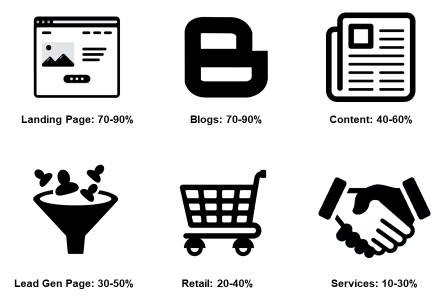What Is A Good Bounce Rate? Understanding Its Limitations

“What is a good bounce rate?” This is a question we get asked all the time. There seems to be a tendency to use bounce rate as a key metric in determining whether or not a website is “working”. A quick Google search of the question above will result in countless generic “rule of thumb” guides proclaiming that, for example, a bounce rate of <30% is good, 30-50% is average, >50% is bad. This is far too simplistic and the answer, unfortunately is a much more ambiguous “it depends”. It depends… It depends on the type of website you have (e.g. blog vs online shop), your websites design, your websites information architecture (e.g. a one page site vs a multi page site), the purpose of the pages in question (e.g. home page vs marketing landing page), and it depends on how your analytics has been set up in the first place. It’s easy to fall into the trap of treating bounce rate as a Key Performance Indicator – it’s a buzz word that everyone is familiar with and it’s there from day one in your Google Analytics reports without the need for any customisation. However, the question that’s being asked shouldn’t really be “What is a good bounce rate?” but rather, “Is bounce rate a relevant KPI for my website?”
How is Bounce Rate calculated in Google Analytics?
Google's definition of Bounce Rate is:
Bounce Rate is the percentage of single-page sessions (i.e. sessions in which the person left your site from the entrance page without interacting with the page).
There are two key aspects to this definition…
1. “Single page sessions”
Pageviews are automatically counted as actions by Google Analytics – if one pageview is recorded and then no subsequent pageview is recorded within 30 minutes that counts as a bounce.
The problem?
If you have a website with a lot of pages that users land on without moving on to another page within 30 minutes, your average bounce rate will inevitably be high. But is not necessarily a bad thing! Think about it… Maybe the visitor actually found your on-page content highly relevant and useful. Maybe they scrolled down the page, consumed everything you had to offer and left happy with a positive image of your brand. Or maybe they:
- Filled out a form that didn’t lead to a new page
- Clicked a pricing tab
- Watched a video
By default none of these will directly lower your bounce rate. If a visitor has arrived on a how-to blog post via an organic search and your content answered their query, is the fact that they left immediately necessarily bad? They may be searching for instructions and immediately getting back to the task at hand, whatever that is, before revisiting in future. If a visitor has arrived to a lead generation landing page and filled out their details, does it really matter if they moved on to another page in your site immediately? You have their contact details now and can follow up via e-mail with a relevant CTA. If the success of your site depends on users viewing more than one page, then, yes, a high bounce rate is bad. If you have a single-page site like a blog, or offer other types of content for which single-page sessions are expected, then a high bounce rate is perfectly normal
2. “Without interacting”
This part of the definition is often overlooked or misunderstood. But it is very important, because it means that it is not only pageviews that affect the bounce rate but also any other defined interactions on the page. In other words, Google actually counts two types of interactions in relation to Bounce Rate: Page Views and Events.
The problem?
As I’ve mentioned, Google tracks pageviews by default – so one way to reduce your bounce rate is to get people to move onto other pages in your site via internal links. However, if you have single page website or a site that relies heavily on Ajax or Flash rather than new page loads, this approach clearly isn’t possible. Or if you’re dealing with a marketing landing page, your priority is more than likely to be to get the user to take a particular action on that page, rather than moving them on to another page. This is where Events can help. Google Analytics Events track how a visitor engages within your page. With Events , you can track form submissions, tab clicks, video plays, downloads and almost anything else that is not automatically tracked by the default implementation of Google Analytics. Each event requires some additional custom code in your website, which can be easily implemented via Google Tag Manager. When a user triggers an event, the interaction stops a bounce from being recorded in Google Analytics even if the user does “bounce” in the conventional sense of the term (i.e. they don’t view any subsequent pages).
![]()
Added benefit: Events can be used as Goals within Google Analytics which enhances the depth and quality of your conversion reports.
How do we solve the Bounce Rate problem?
By tracking all valuable interactions on your pages with Events ! Essentially, Events solve both of the Bounce Rate problems I’ve mentioned above by:
- Reducing the bounce rate on pages on which users leave within 30 minutes, but take a valuable action
- Providing new alternative engagement metrics to bounce rate
What Events should we set up?
So what Events can we set up that will offer us new relevant engagement metrics within Google Analytics, whilst at the same time reducing our bounce rate? The list is literally endless – but below are 4
Scroll Tracking
For content heavy pages that provide the visitor with detailed information on a particular topic (for example “How To” blog posts), scroll tracking allows you to track how far users are scrolling down your page. This will give you an idea of how engaging your content is whilst at the same time allowing inhibit a bounce when users scroll past a certain distance, thus lowering your bounce rate.
Form Submissions
In an ideal world from an analytics perspective, when a user successfully fills out a form, they would be redirected to a Thank You page. This configuration ensures that a bounce does not happen on the initial page, whilst at the same time making conversion tracking a whole lot simpler. However, in reality, this is often not the case. For forms that don’t lead to a Thank You page, we can use event tracking to track successful form submissions. This successful submission event can be used as a Goal in Google Analytics for conversion tracking and can also be set up in a way that stops a bounce from happening, which again, will lower your bounce rate.
File Downloads
Again, very often a file download will not automatically open up a new page – instead the file will be automatically downloaded in your browser. Luckily, we can track file downloads as Goals (conversions) via event tracking and ensure that if a file is downloaded, a bounce is not recorded.
Video Plays
If the main content of your landing page is a video, then the user is likely to simply watch that video within 29 minutes move on. Event tracking allows you to track video interactions in great detail – you can track plays of a video as well as tracking duration intervals to which users watch your video. Again this offers benefits in terms of both providing more detailed engagement metrics and reducing your bounce rate.
The Bottom Line
Using Bounce Rate as an engagement KPI is very tempting. But misinterpreted, it is also very prone to error. Therefore it is extremely important to be aware of what exactly Bounce Rate is. Now that you know the actual definition, you’re in a position to decide whether it really is an important KPI for your website, or a subsection of your website (It is possible for bounce rate to be a relevant engagement metric for some parts of your site, but not for others – see this article for more info). You’re also in a position to go about tracking other, more relevant engagement KPIs that have the added benefit of reducing your sites average bounce rate at the same time. For those of you who still insist on setting a target bounce rate for your website, fine... here is a list of average bounce rates for different types of websites / web pages (stats via HubSpot) - but remember, you're bounce rate may be misleading and bounce rate may not be a relevant KPI for website.

If you have any questions on Bounce Rates or anything else Google Analytics related, feel free contact us on 01-9052030 or Get In Touch.
Related Services:
/ai-april.webp?sfvrsn=23da3026_1)
/blog-1.webp?sfvrsn=bf4fb901_2)
/ai---web-design-and-development-innovation.webp?sfvrsn=cc684efd_2)